...
| 2.0.0 | 18 Jul 2017 | Open Banking Open Data API Team | This is the baseline version. |
| 2.1.0 | 21 Aug 2017 | Open Banking Open Data API Team | This release incorporates all known issues with 2.0.0 up to 18 Aug 2017. Please see the release notes for details. |
| 2.1.1 | 12 Oct 2017 | Open Banking Open Data API Team | For BCA, this release is identical to v2.1.0 API. Please see the 2.1.0 release notes for details. The MIG is from v2.2 (as recommended by PMG) |
...
This endpoint can contain multiple brands owned by a particular banking group. Each brand can own multiple BCA products.
BCA
This section covers BCA attributes that will change only under rare circumstances (see CoreProduct section for additional attributes that will be updated regularly).
The following information can be provided:-
- Product Name i.e. the name marketed to the consumers.
- Identification is the unique id created by the financial institution to internally define the product
- Segment - allows specification of the type of product e.g. basic, regular, premium
MarketingState
Within our design, we have a concept of a "marketing state" for the product. This concept is required because for any "On Sale" BCA product:-
- The BCA may provide a different offering to the account holder the longer that they hold a particular BCA - covered by StateTenureLength & StateTenurePeriod in the example below.
- The financial institution can change any of the BCA attributes that are marketed over time - covered by FirstMarketedDate and LastMarketedDate in the example below.
We'll illustrate this with a complex example.
CMA9Bank has a BCA product that was first advertised on 1/1/2017 and has the following features currently:-
- If the accountholder takes the product, they are offered a promotional interest rate of 0.5% for 1st 9 months, then 0.2% for next 12 months and then it reverts back to the standard variable rate (e.g. 0%).
...
This sections includes information that can change relatively often. Information to be provided includes:-
- Product URL allows a link to the financial institution's website where more detail about the product can be found
- URL to the product's terms & conditions
- Sales Access Channels cover all of the channels by which a customer can be sold a BCA
- Servicing Access Channels cover all of the channels by which a customer can receive service for their BCA. Note: This covers servicing of all aspects of the BCA. Some aspects may not be serviceable via certain channels.
- MonthlyCharge covers any monthly servicing charge that a financial institution may make to a BCA accountholder
Credit Interest
In this section, information about the interest rates that are payable to the consumer are listed. Interest rates are typically standard variable rates, with rates potentially changing many times during the course of the products. In addition to the 'Regular' standard variable rates, some BCA products also provide for more attractive 'Promotion' interest rates which are fixed for a relatively short duration. (see MarketingState section above as to how to represent these).
...
Message Implementation Guide
...
Purpose
The message implementation guide (MIG) is designed to assist the implementers of the messaging specfication by providing worked examples as to how the message fields should be completed in different scenarios.
The intention is that this will better ensure consistency. This guide should be read alongside the data dictionary which provides fuller information about the rules, constraints and guidelines that should be adhered to when populating the fields.
We are choosing different accounts based on how fully they test each section of the design.
OtherFeesAndCharges isn’t covered by the use cases due to these currently being bank propriatary fees/charged and not standardised currently. Key standardised Fees and Charges covering overdraft and benefits are covered in the relevant examples stated above, however.
Format Notation
The format that we use in this document for field value assignment is:-
[] enclose a set of field values.
Where there are multiple records for a particular field, we depict this as [<record 1 value1>,< record 1 value2>…<recordn valuen>], whilst where we are showing that there is 1 field value in 1 record, and another field value in a 2nd record, I depict this as [<record1 value1>],[<record 2 value 1>],[<record 3 value 3>]
, seperates individual field values within a field value set.
“ surrounds a text or date field value.
Implementation Notes
Before implementing the message standard, it is very useful browsing the current market leading price comparison websites (e.g. http://www.knowyourmoney.co.uk/business-current-accounts/, http://www.moneysupermarket.com/current-accounts/business-bank-accounts/ to understand how implementation of our standard by the CMA9 banks would help to more easily facilitate provision of information used on those sites.
Currently, price comparison websites have to obtain their BCA product data either via bank proprietary APIs, via information collected by dedicated data capture agencies or via "screen scraping" (i.e. capturing product web page information and writing scripts to extract relevant data). This work is complex and prone to error, so having a standard API would make the data capture side much easier and allow more third party providers to provide applications that could target particular consumer markets.
| Expand |
|---|
| title | BCA v2.0 Top Level Design |
|---|
|
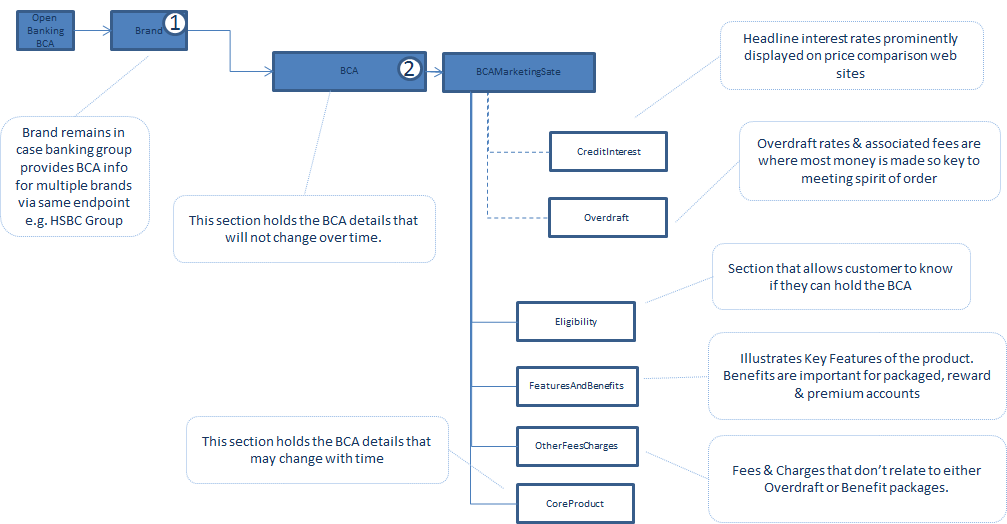 Image Added Image Added
| Section Number | Field Name | Cardinality | Values |
|---|
| 1 | BrandName | 1..1 | "Barclays" | | 2 | Name | 1..1 | "Mixed Payments Plan" | | 2 | Identification | 1..1 | "MPP" | | 2 | Segment(Enumeration: OB_BCAProductSegment1Code) | 1..* | "Business" |
|
| Expand |
|---|
| title | How I can publish “Startup” or “Switching” incentives? |
|---|
|
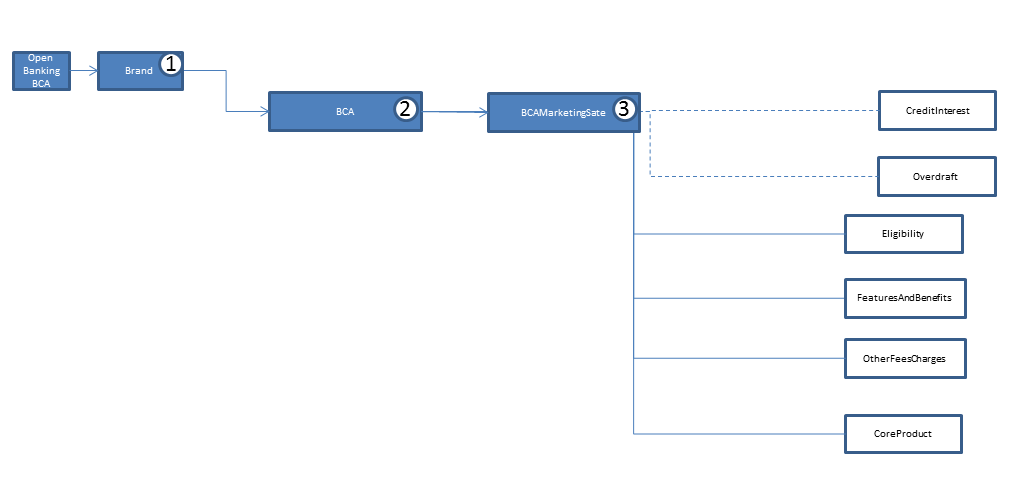 Image Added Image Added
Example: HSBC Start Up Account Free banking for 18 months when you start your business with HSBC. After your free business banking period, we'll give you a fixed price of £5.50 a month for 12 months. When your fixed price period ends you’ll move onto the tariff that you choose when you open your account and you’ll pay an account maintenance fee of £5.50 per month plus charges depending on the services you use. | Section Number | Field Name | Cardinality | Value(s) |
|---|
| 1 | BrandName | 1..1 | “HSBC UK” | | 2 | Name M
| 1..1 | “HSBC Startup Account” | | 2 | Identification | 1..1 | “STARTUPACCT1T” | | 2 | Segment(Enumeration OB_BCAProductSegment1Code) | 1..* | “Startup” | | 3 | Identification | 1..1 | [“P1”][“P2”][“R2”] | | 3 | PredecessorID | 0..1 | [][“P1”][“P2”] | | 3 | MarketingState (Enumeration: OB_MarketingState1Code) | 1..1 | [“Promotional”][“Promotional”][“Regular”] | | 3 | FirstMarketedDate | 0..1 | [“1/1/1900”],[“1/1/1900”], [“1/1/1900”] | | 3 | LastMarketedDate | 0..1 | [“31/12/9999”],[“31/12/9999”], [“31/12/9999”] | | 3 | StateTenureLength | 0..1 | [18][12][] | | 3 | StateTenurePeriod (Enumeration: OB_Period1Code) | 0..1 | [“Month”][“Month”][] | | 3 | Notes | 0..* | [“Free banking for 18 months when you start your business with HSBC”][“After your free business banking period, we'll give you a fixed price of £5.50 a month for 12 months.”][“When your fixed price period ends you’ll move onto the tariff that you choose when you open your account and you’ll pay an account maintenance fee of £5.50 per month plus charges depending on the services you use.”] |
|
| Expand |
|---|
| title | How I can supply fixed and variable core product details? |
|---|
|
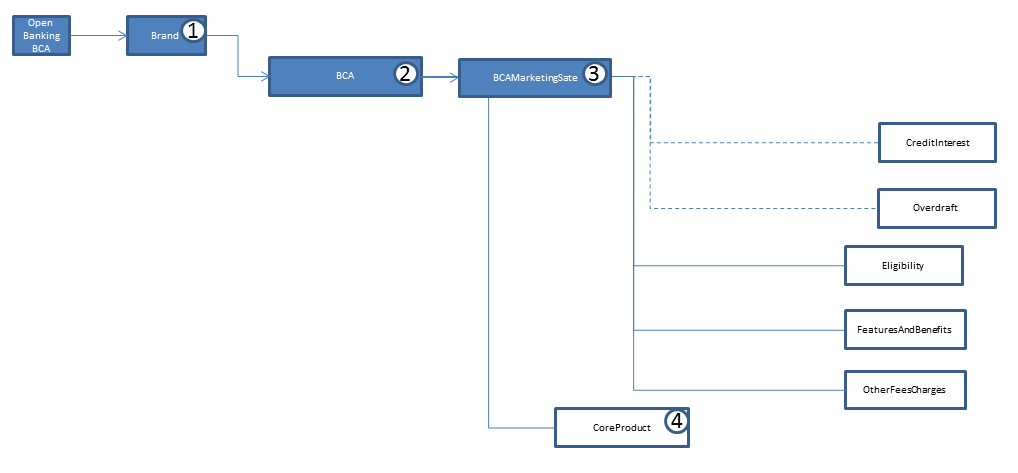 Image Added Image Added
Example: Bank of Scotland’s Islamic Business Account Start-up For new businesses with a turnover up to £1 million, our Business Current Account includes: - 18 months' free day-to-day business banking*
- Simple pricing with free electronic payments
- Business support available by phone, in branch or through online guides
| Section Number | Field Name | Cardinality | Value(s) |
|---|
1 | BrandName | 1..1 | “Bank of Scotland” | | 2 | Name | 1..1 | ”Islamic Business Account Start-up” | | 2 | Identification | 1..1 | ” BRBB_BCA_007” | | 2 | Segment(Enumeration OB_BCAProductSegment1Code) | 1..* | [“Religious”,”Startup”] | | 3 | Identification | 1..1 | [ “P1”][“R1”] | | 3 | MarketingState (Enumeration: OB_MarketingState1Code) | 1..1 | [“Promotional”][”Regular”] | | 3 | PredecessorID | 0..1 | [],[“P1”] | | 3 | FirstMarketedDate | 0..1 | [“1/1/1990”][“1/1/1990”] | | 3 | LastMarketedDate | 0..1 | [“31/12/9999”][“31/12/9999”] | | 3 | StateTenureLength | 0..1 | [18][] | | 3 | StateTenurePeriod (Enumeration: OB_Period1Code) | 0..1 | [“Month”][] | | 3 | Notes |
|
| | 4 | ProductURL | 1..1 | http://business.bankofscotland.co.uk/0-1m-turnover/business-accounts/ | | 4 | ProductDescription |
|
| | 4 | TcsAndCsURL | 1..1 | ”http://business.bankofscotland.co.uk/business-home/rates-and-charges/terms-and-conditions/shared/BoS_BB62566_300521AP_0116_V1_Web.pdf” | | 4 | SalesAccessChannels (Enumeration: OB_SalesAccessChannels1Code) | 1..* | [“Branch”, “Online”,] | | 4 | ServicingAccessChannels (Enumeration: OB_ServicingAccessChannels1Code) | 1..* | [“Branch”, “Online”, “Phone”, “MobileApps”, “Post”] | | 4 | MonthlyCharge |
|
|
|
| Expand |
|---|
| title | How can I represent a business overdraft fees? |
|---|
|
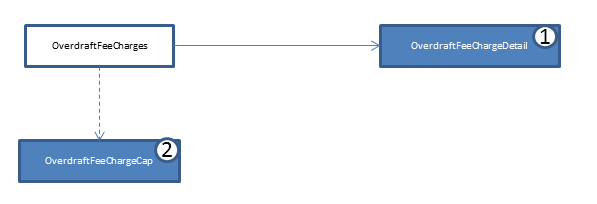 Image Added Image Added
Example: Bank of Ireland (Northern Ireland) - Lending Fees (including overdraft)
- Lending Set-up Fee - Negotiable (min £100.00)
- Temporary Overdraft - 1% (min £100.00)
- Annual Overdraft Fee - 0.5% ( min £50.00)
| Section Number | Field Name | Cardinality | Value(s) |
|---|
| 2 | FeeType (Enumeration:OB_OverdraftFeeType1Code) | 1..* | [“OverdraftSetup”][“TempOverdraft”][“OverdraftRenewal”] | | 2 | OtherFeeType (OtherCodeType) |
|
| | 2 | MinMaxType (Enumeration: OB_MinMaxType1Code) | 1..1 | [“Minimum”][“Minimum”][“Minimum”] | | 2 | FeeCapOccurrence |
|
| | 2 | FeeCapAmount | 0..1 | [100.00][100.00][50.00] | | 2 | CappingPeriod (Enumeration:OB_Period1Code) |
|
| | 2 | Notes |
|
| | 1 | FeeType(Enumeration:OB_OverdraftFeeType1Code) | 1..1 | [“OverdraftSetup”][“TempOverdraft”][“OverdraftRenewal”] | | 1 | OtherFeeType (OtherCodeType) |
|
| | 1 | NegotiableIndicator | 0..1 | [True][][] | | 1 | OverdraftControlIndicator |
|
| | 1 | IncrementalBorrowingAmount |
|
| | 1 | FeeAmount |
|
| | 1 | FeeRate | 0..1 | [][1][0.5] | | 1 | FeeRateType (Enumeration: OB_InterestRateType1Code) |
|
| | 1 | OtherFeeRateType (OtherCodeType) |
|
| | 1 | ApplicationFrequency (Enumeration: OB_FeeFrequency1Code) | 1..1 | [“OnOpening”][“Monthly”][“OnAnniversary”] | | 1 | OtherApplicationFrequency (OtherCodeType) |
|
| | 1 | CalculationFrequency (Enumeration: OB_FeeFrequency1Code) | 1..1 | [“OnOpening”][“Daily”][“OnAnniversary”] | | 1 | OtherCalculationFrequency (OtherCodeType) |
|
| | 1 | Notes |
|
|
|
| Expand |
|---|
| title | How do I represent an introductory offer? |
|---|
|
 Image Added Image Added
(1) Marketing State
Example: Santander Business Current Account Start Up Small to medium sized businesses (turnover <£2.5m) in the first year of trading, has up to two directors, owners (shareholders) or partners and this is its first Business Current Account with us, you could be eligible for 12 months free business banking
Notes:
1.It’s preferable to provide default values for dates in order to make it easier to query which marketing states are operative on a particular date.
2.Marketing state is only intended to cover the current and near term future changes in promotional and regular offers, which need to be presented to the customer when marketed. It is not intended to provide a change history going back in time. | Section Number | Field Name | Cardinality | Value(s) |
|---|
| 1 | Identification | 1..1 | [ “P1”][“R1”] | | 1 | MarketingState (Enumeration: OB_MarketingState1Code) | 1..1 | [“Promotional”][”Regular”] | | 1 | PredecessorID: | 0..1 | [],[“P1”] | | 1 | FirstMarketedDate | 0..1 | [“1/1/1990”][“1/1/1990”] | | 1 | LastMarketedDate | 0..1 | [“31/12/9999”][“31/12/9999”] | | 1 | StateTenureLength | 0..1 | [“12”][] | | 1 | StateTenurePeriod (Enumeration: OB_Period1Code) | 0..1 | [“Month”][] | | 1 | Notes | 0..* | [“Small to medium sized businesses (turnover <£2.5m) in the first year of trading, has up to two directors, owners (shareholders) or partners and this is its first Business Current Account with us, you could be eligible for 12 months free business banking”] |
|
| Expand |
|---|
| title | How can I show whole credit interest rates? |
|---|
|
 Image Added Image Added
Example: Lloyds School Banking Account - 0.05% fixed interest
- No interest-related eligibility criteria specified.
| Section Number | Field Name | Cardinality | Value(s) |
|---|
| 1 | CalculationMethod (Enumeration: OB_InterestCalculationMethod1Code) | 0..1 | “Compound” | | 1 | Destination(Enumeration: OB_InterestDestination1Code) |
|
| | 1 | TierBandMethod (Enumeration: OB_TierBandType1Code) | 1..1 | “Whole” | | 1 | Notes | 0..* | “£1 minimum balance” | | 2 | Identification |
|
| | 2 | TierValueMinimum | 1..1 | 1 | | 2 | TierValueMaximum |
|
| | 2 | CalculationFrequency (Enumeration: OB_Frequency1Code) | 1..1 | “Monthly” | | 2 | OtherCalculationFrequency |
|
| | 2 | ApplicationFrequency(Enumeration: OB_Frequency1Code) | 1..1 | “Monthly” | | 2 | OtherApplicationFrequency |
|
| | 2 | DepositInterestAppliedCoverage (Enumeration: OB_TierBandType1Code) | 0..1 | “Whole” | | 2 | FixedVariableInterestRateType(Enumeration: OB_InterestFixedVariableType1Code) | 1..1 | “Fixed” | | 2 | AER | 1..1 | 0.05 | | 2 | BankInterestRateType (Enumeration: OB_InterestType1Code) | 0..1 | “Gross” | | 2 | OtherBankInterestType |
|
| | 2 | BankInterestRate |
|
| | 2 | Notes |
|
|
|
| Expand |
|---|
| title | What if I wish to restrict who can apply for the account? |
|---|
|
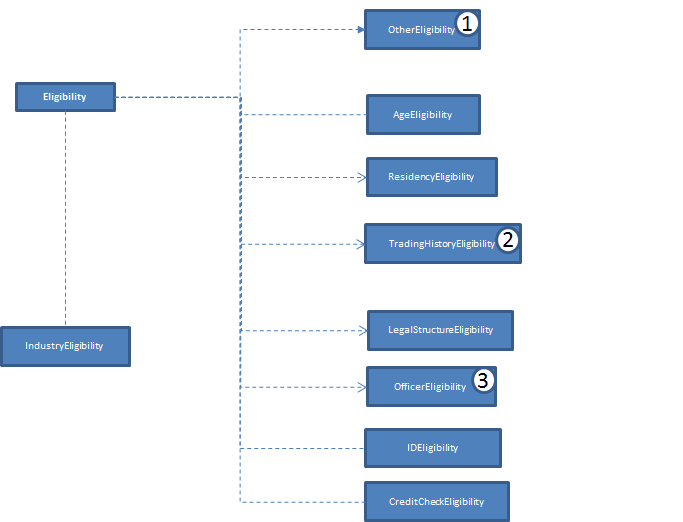 Image Added Image Added
Example: Santander Business Account 2Year Start Up Eligibility requirements - Annual Turnover <£2.5m
- Has up to 2 directors, owners (shareholders) or partners
- 1st BCA
| Section Number | Field Name | Cardinality | Value(s) |
|---|
| 1 | Name | 1..1 | [“1st BCA”] | | 1 | Description |
|
| | 1 | Type (Enumeration: OB_BCAEligibilityType1Code) | 1..1 | [“SoleUKAccount”] | | 1 | OtherType (OtherCodeType) |
|
| | 1 | Amount |
|
| | 1 | Indicator |
|
| | 1 | Textual |
|
| | 1 | Period (Enumeration: OB_Period1Code) |
|
| | 1 | Notes |
|
| | 2 | TradingType (Enumeration: OB_TradingEligibilityType1Code) | 0..1 | [“Turnover”] | | 2 | MinMaxType (Enumeration: OB_MinMaxType1Code) | 0..1 | [“Maximum”] | | 2 | Amount | 0..1 | [2500000] | | 2 | Indicator |
|
| | 2 | Textual |
|
| | 2 | Period (Enumeration: OB_Period1Code) |
|
| | 2 | Notes |
|
| | 3 | OfficerType (OB_OfficerType1Code) | 0..1 | [“Director”][“Owner”][“Partner”] | | 3 | OtherOfficerType |
| | | 3 | MinAmount |
|
| | 3 | MaxAmount | 0..1 | [2][2][2] | | 3 | Notes |
|
|
|
| Expand |
|---|
| title | What about benefits packages? |
|---|
|
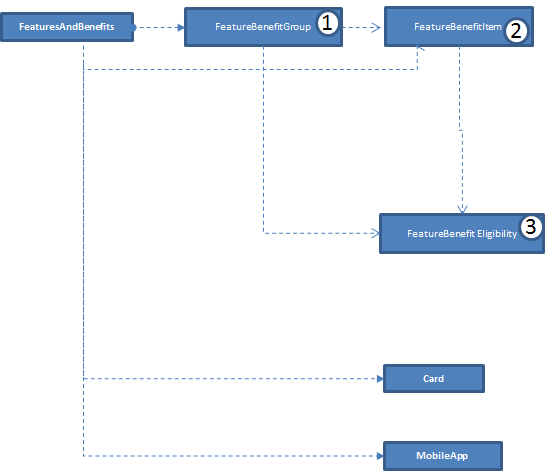 Image Added Image Added
Example: Danske Small Business Cashback £500 for Cashback for new small business customers First £250 paid after 10 transactions Final £250 paid after 12 months banking
| Section Number | Field Name | Cardinality | Value(s) |
|---|
| 1 | Name | 1..1 | “£500 Cashback” | | 1 | Type (Enumeration: OB_FeatureBenefitType1Code) | 0..1 | [“Cashback”] | | 1 | OtherType (OtherCodeType |
|
| | 1 | BenefitGroupNominalValue: | 0..1 | 500.00 | | 1 | |
|
| | 1 | ApplicationFrequency (Enumeration: OB_Frequency1Code) |
|
| | 1 | OtherApplicationFrequency (OtherCodeType) |
|
| | 1 | CalculationFrequency (Enumeration: OB_Frequency1Code) |
|
| | 1 | OtherCalculationFrequency (Enumeration: OB_Frequency1Code) |
|
| | 1 | Notes |
|
| | 2 | Identification | 0..1 | [1],[2] | | 2 | Type (Enumeration: OB_FeatureBenefitType1Code) | 1..1 | [“Cashback”][“Cashback”] | | 2 | OtherType (OtherCodeType) |
|
| | 2 | Amount | 0..1 | [250.00][250.00] | | 2 | Indicator |
|
| | 2 | Textual |
|
| | 2 | Notes | 0..* | [“£250 Cashback after 10 transactions”][“£250 Cashback on 1 Year Anniversary”] | | 3 | Name | 1..1 | [“After 10 Transaction”][“On 1st Anniversary”][“New Customers Only”] | | 3 | Description |
|
| | 3 | Type (Enumeration: OB_BCAEligibilityType1Code) | 1..1 | [“MinimumTransactions”[“MinimumAnniversary”][“NewCustomersOnly”] | | 3 | OtherType (OtherCodeType) |
|
| | 3 | Amount | 0..1 | [10][1][] | | 3 | Indicator |
|
| | 3 | Textual |
|
| | 3 | Period (Enumeration: OB_Period1Code) | 0..1 | [][“Year”][] | | 3 | Notes |
|
|
|
| Expand |
|---|
| title | What about Tariffs and “Other Fees And Charges”? |
|---|
|
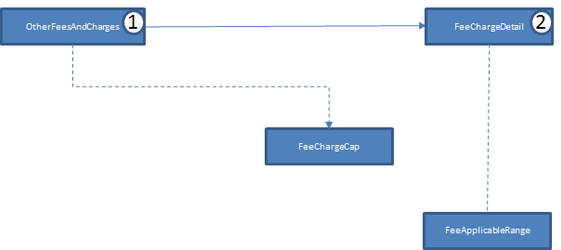 Image Added Image Added
Example: HSBC Business Current Account The CMA in their price comparison exercise prior to OBIE being established took the view that the following charges are key - I identify the FeeType in each case, so I’m using these as examples of FeeTypes. Where there are “per payment”,“per debit”,”per withdrawal” or “per cheque” charges indicated, you should use the “PerItem” CalculationFrequency :-
1.Automatic credit payment in. [“AutoAutoCredit”]
2.Bill payment out (via phone or internet) [“TransBankPayment”]
3.Debit card payment out [“TransDebCardDeb”]
4.Direct debit payment out [“TransUKDirDeb”]
5.Standing order payment out [“TransStandingOrd”]
6.Branch payment in (cheques or cash) [“TransBranchCredit”]
7.Branch payment out [“TransBillPaymentCash”]
8.Branch cash payment in (additional charge for handling cash) [“CounterCashIn”]
9.Branch cash payment out (additional charge for handling cash) [“CounterCashOut”] | Section Number | Field Name | Cardinality | Value(s) |
|---|
| 1 | TariffType (Enumeration:OB_TariffType1Code | 0..1 | [“Mixed”][“Electronic”] | | 1 | TariffName | 0..1 | [“Small Business Tariff”][“Electronic Banking Tariff”] | | 1 | OtherTariffType (OtherCodeType) |
|
| | 2 | FeeCategory (Enumeration: OB_FeeCategory1Code) | 1..1 | [“Servicing”][“Servicing”] | | 2 | FeeType (Enumeration: OB_FeeType1Code) | 1..1 | [“ServiceCFixedTariff”] | | 2 | OtherFeeType (OtherCodeType + extra category field ) |
|
| | 2 | NegotiableIndicator |
|
| | 2 | IncludedInMonthlyChargeIndicator |
|
| | 2 | FeeAmount | 0..1 | [5.50][5.50] | | 2 | FeeRate |
|
| | 2 | FeeRateType (Enumeration: OB_InterestRateType1Code) |
|
| | 2 | OtherFeeRateType (OtherCodeType) |
|
| | 2 | ApplicationFrequency (Enumeration: OB_FeeFrequency1Code) |
|
| | 2 | OtherApplicationFrequency (OtherCodeType) |
|
| | 2 | CalculationFrequency (Enumeration: OB_FeeFrequency1Code) | 1..1 | [“Monthly”][“Monthly”] | | 2 | OtherCalculationFrequency (OtherCodeType) |
|
| | 2 | Notes |
|
|
|





